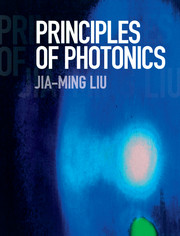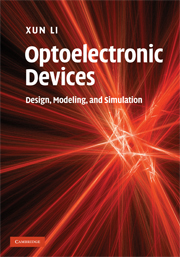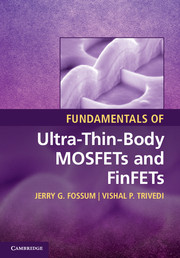Silicon Photonics Design
From Devices to Systems
- Authors:
- Lukas Chrostowski, University of British Columbia, Vancouver
- Michael Hochberg, Coriant Advanced Technology Group
- Date Published: March 2015
- availability: Available
- format: Hardback
- isbn: 9781107085459
Hardback
Other available formats:
eBook
Looking for an inspection copy?
This title is not currently available on inspection
-
From design and simulation through to testing and fabrication, this hands-on introduction to silicon photonics engineering equips students with everything they need to begin creating foundry-ready designs. In-depth discussion of real-world issues and fabrication challenges ensures that students are fully equipped for careers in industry. Step-by-step tutorials, straightforward examples, and illustrative source code fragments guide students through every aspect of the design process, providing a practical framework for developing and refining key skills. Offering industry-ready expertise, the text supports existing PDKs for CMOS UV-lithography foundry services (OpSIS, ePIXfab, imec, LETI, IME and CMC) and the development of new kits for proprietary processes and clean-room based research. Accompanied by additional online resources to support students, this is the perfect learning package for senior undergraduate and graduate students studying silicon photonics design, and academic and industrial researchers involved in the development and manufacture of new silicon photonics systems.
Read more- Employs minimal mathematics and derivations, placing a greater emphasis on practical understanding
- Covers passive components, active components including modulators, detectors and lasers, and big-picture systems design
- Addresses real-world fabrication challenges including non-uniformity, automated wafer- and chip-level testing, packaging, and design for test and manufacturability considerations
Reviews & endorsements
'This publication's wide variety of topics should stimulate people to read and discover the sensing potential of optical fiber and devices. This book is a comprehensive introduction to the field with a strong practical focus that undergraduate and graduate students will find useful. It could also serve as a reference for scientists and engineers who are working in the optical fiber sensing area.' Lisa Tongning Li, Optics and Photonics News
Customer reviews
Review was not posted due to profanity
×Product details
- Date Published: March 2015
- format: Hardback
- isbn: 9781107085459
- length: 437 pages
- dimensions: 256 x 182 x 23 mm
- weight: 1.02kg
- contains: 250 colour illus.
- availability: Available
Table of Contents
Part I. Silicon Photonics - Introduction:
1. Fabless Silicon Photonics:
1.1 Introduction
1.2 Silicon photonics - the next fabless semiconductor industry
1.3 Applications
1.4 Technical challenges and the state of the art
1.5 Opportunities
2. Modelling and Design Approaches:
2.1 Optical Waveguide Mode Solver
2.2 Wave Propagation
2.3 Optoelectronic models
2.4 Microwave Modelling
2.5 Thermal Modelling
2.6 Photonic Circuit Modelling
2.7 Physical Layout
2.8 Software Tools Integration
Part II. Silicon Photonics - Passive Components:
3. Optical Materials and Waveguides:
3.1 Silicon-on-Insulator
3.2 Waveguides
3.3 Bent waveguides
3.4 Code Listings
3.5 Problems
4. Fundamental Building Blocks:
4.1 Directional couplers
4.2 Y-Branch
4.3 Mach-Zehnder Interferometer
4.4 Ring resonators
4.5 Waveguide Bragg Grating Filters
4.6 Code Listings
4.7 Problems
5. Optical I/O:
5.1 The challenge of optical coupling to silicon photonic chips
5.2 Grating Coupler
5.3 Edge Coupler
5.4 Polarization
5.5 Code Listings
5.6 Problems
Part III. Silicon Photonics - Active Components:
6. Modulators:
6.1 Plasma Dispersion E
6.2 PN Junction Phase Shifter
6.3 Micro-ring Modulators
6.4 Forward-biased PIN Junction
6.5 Active Tuning
6.6 Thermo-Optic Switch
6.7 Code Listings
6.8 Problems
7. Detectors:
7.1 Performance Parameters
7.2 Fabrication
7.3 Types of detectors
7.4 Design Considerations
7.5 Detector modelling
7.5.2 Electronic Simulations
7.6 Code Listings
7.7 Problems
8. Lasers:
8.1 External Lasers
8.2 Laser Modelling
8.3 Co-Packaging
8.4 Hybrid Silicon Lasers
8.5 Monolithic Lasers
8.6 Alternative Light Sources
8.7 Problems
Part IV. Silicon Photonics - System Design:
9. Photonic Circuit Modelling:
9.1 Need for photonic circuit modelling
9.2 Components for System Design
9.3 Compact Models
9.4 Directional Coupler - Compact Model
9.5 Ring Modulator - Circuit Model
9.6 Grating Coupler - S Parameters
9.7 Code Listings
10. Tools and Techniques:
10.1 Process Design Kit (PDK)
10.2 Mask Layout
11. Fabrication:
11.1 Fabrication Non-Uniformity
11.2 Problems
12. Testing and Packaging:
12.1 Electrical and Optical Interfacing
12.2 Automated Optical Probe Stations
12.3 Design for Test
13. Silicon Photonic System Example:
13.1 Wavelength Division Multiplexed Transmitter.-
General Resources
Find resources associated with this title
Type Name Unlocked * Format Size Showing of
This title is supported by one or more locked resources. Access to locked resources is granted exclusively by Cambridge University Press to lecturers whose faculty status has been verified. To gain access to locked resources, lecturers should sign in to or register for a Cambridge user account.
Please use locked resources responsibly and exercise your professional discretion when choosing how you share these materials with your students. Other lecturers may wish to use locked resources for assessment purposes and their usefulness is undermined when the source files (for example, solution manuals or test banks) are shared online or via social networks.
Supplementary resources are subject to copyright. Lecturers are permitted to view, print or download these resources for use in their teaching, but may not change them or use them for commercial gain.
If you are having problems accessing these resources please contact lecturers@cambridge.org.
Sorry, this resource is locked
Please register or sign in to request access. If you are having problems accessing these resources please email lecturers@cambridge.org
Register Sign in» Proceed
You are now leaving the Cambridge University Press website. Your eBook purchase and download will be completed by our partner www.ebooks.com. Please see the permission section of the www.ebooks.com catalogue page for details of the print & copy limits on our eBooks.
Continue ×Are you sure you want to delete your account?
This cannot be undone.
Thank you for your feedback which will help us improve our service.
If you requested a response, we will make sure to get back to you shortly.
×




